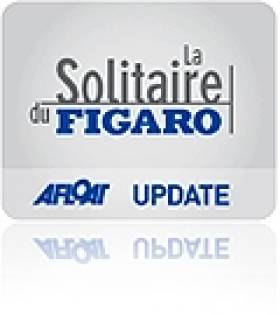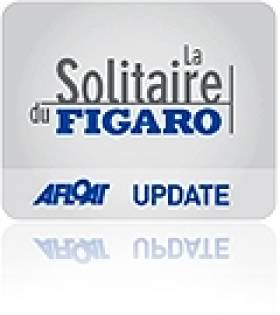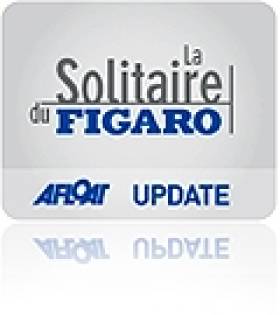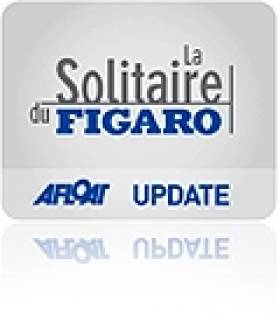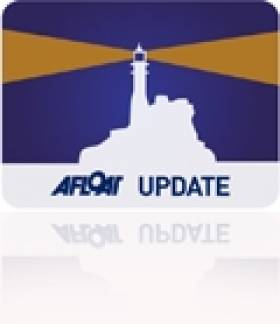Displaying items by tag: Full Irish
#fullrish – Solo Irish sailor David Kenefick sends Afloat.ie this update from Leg three of the La Solitaire Du Figaro race
That was tough, frustrating and it seemed to be long but in fact it wasn't excessive. I started nicely at the pin end and sailed a good inshore part of the course and enjoyed the fight. I find that its so much easier to start the at the pin end and make your way safely to the left of the course before the approach to the top of the course. If the line is biased to the left it works really well, if the line is neutral or tot the right there is plenty of room and you totally stay out of trouble and the worst position you'll have at the top mark is in the teens.
The first legs are always long, over two miles and I like to get settled into sailing fast upwind straight away and not being compromised by too many boats around me. But alas the Figaro is not about being well placed after an hour, its about being well placed after 72-100 hours. To be well placed though it helps to be in the front pack at the beginning because it is rare that the back-markers get all the way back to the front. I'm in fifth place overall for the inshore prize. Once in the front pack then it is all about two things, risk management and boatspeed. Boatspeed doesn't always come easily in a One Design class like this, there simply is no shortage of experience which I'm still looking to accumulate.
Risk management is a nice way of saying don't lose touch by going away from the group you are with. The race is about attrition. Over the days and nights the fleet gets spread out, its natural and its because you miss things or you are tired and not sailing at your best. If you manage to stay with the pack and sleep and stay sharp you will manage to last longer in the pack. Its taken me a while to work all this out, two years now and Leg 3 was going well for the first 24 hours. It got pretty complicated at Belle Ile where there was an almighty park up but I managed to get away in about the same place that I came into it.
The run offshore to ODAS was going well for me too but at around eight the next morning the boats just a few hundred metres ahead of us seemed to just get something first and started to sail away from everybody else. Very quickly this was a break and our group, the bulk of the fleet got left behind. It was terrible because there was nothing we could do except be philosophical about it.
At one stage the leading group was more than five hours ahead of us. 24 hours later and we had an opportunity to close the gap down when the leaders ran out of wind close to Ile de Ré on the last segment to the finish. We didn't pass them but the gap went back to one hour instead of five.
I finished mid-morning, I'm shattered and burnt and hungry. We have just over two days to turn it around and head back out again for the final leg to Cherbourg which starts on Sunday.
But tonight a Comptoir Irlandais Whiskey tasting event with my sponsors and fellow skippers.
Kenefick Sails into Roscoff with La Solitaire Figaro Fleet
#fullirish – Royal Cork's David Kenefick and The La Solitaire du Figaro fleet sailed in to Roscoff this morning at the end of two with the solo Irish sailor now 25th overall from 38 after the second stage of four in the intrepid race. Straight from his Full Irish nboat he has sent Afloat.ie readers the following report:
'That was a tough leg, but they always are. I shouldn't be frustrated, I'm hitting good places from time to time. I'm often playing well into the top half of the fleet and the top ten which was never the case last year. I'm going fast, faster than I ever have before and I',m always in the pack. This last leg was one that was rather unusual. There weren't many opportunities to do anything other than lose places. I had a good start and a really good second beat meaning I was in a good eighth place leaving Plymouth. My first big mistake was sailing too close to the Lizard off the South West Coast of England. We were really late starting and the tide was away by the time we got there and there was better pressure offshore. I lost a couple of miles there, miles that were never going to come back.
The Scillys were amazing with this great weather we are having. Dodging the various TSS zones kept us working hard and the long tight white sail reach out to the Stags was actually rather monotonous. It was difficult to stay awake on this leg and I had to sleep a lot. Just a few degrees up or down seemed to make quite a difference in the shifty dropping breeze.
It was great to see this small RIB approaching me at seven in the morning 10 miles off the Irish coast. I had a feeling that something like this would happen but when I saw Neil (dad) and George (brother) on board, well it was a special moment. I'd like to have been further up the fleet but they could see I was in the pack. Plenty of moral encouragement and banter...
Eventually when we got to the Stags off the Irish coast the fleet had bunched up again and pretty much all boats were in sight after two days. The run down the coast past Baltimore, Sherkin and Cape Clear was a great time, Dolphins and Whales and all my competitors raving about the wildlife and the good weather and the scenery on the VHF.
I was the first of the fleet to gybe offshore to try and get better breeze away from Cape Clear, and approaching the Fastnet with my Shamrock spinnaker set will be a photograph to keep.
The way back to Roscoff saw us tight reaching under headsails and at every corner we got lifted and were able to make it without tacking. It took a really long time and there were times I was fast and putting distance on people I've been training with over the winter and people who beat me big time last year.
We got into Roscoff just before dawn this morning and I finished 23rd, three and a half hours behind Yann Elies who is on fire with speed. He was leading the first leg when he dropped his mast at the Wolf Rock and then won this leg by almost an hour from the second boat. Impossible for him to win three in a row counting a retirement but a class act to sail with. I'm 25th overall after two legs and just five hours off the lead. After two legs it is still a very compact leaderboard and a huge amount can still happen over the next two legs. I'm gonna rest for the next few days, the next start is on Sunday 22nd June and it is looking like a windy downwind slide for the first two days. Looking forward to it, but not straight away. Thanks for you support.'
The skipper of Groupe Queguiner was first across the line in Roscoff at the end of Leg 2 of La Solitaire du Figaro-Eric Bompard. Elies finished at 01:26:01 after 3 days 3 hours 0 minutes and 01 second with an average speed of 7.3kn over the 535nm Leg. Corentin Horeau (Bretagne - Credit Mutuel Performance) finished second in the second Leg of La Solitaire du Figaro-Eric Bompard cachemire at 01:24:43 BST.
Jeremie Beyou (Maitre Coq) finished in 3rd, 40 seconds later at 01:25:47BST and Fabien Delahaye (Skipper Macif) crossed the line in 4th at 01:26:19BST
First ten finishers, stage 2:
1. Groupe Queguiner - Leucemie Espoir, Yann Elies
2. Bretagne Credit Mutuel Performance, Corentin Horeau
3. Maitre Coq, Jeremie Beyou
4. Skipper Macif 2012, Fabien Delahaye
5. Interface Concept, Gildas Mahe
6. Agir Recouvrement, Adrien Hardy
7. Groupe Fiva, Alexis Loison
8. Normandy Elite Team, Charlie Dalin
9. Cercle Vert, Gildas Morvan
10. Un Maillot Pour La Vie, Corentin Douguet
After 2 stages, overall top ten:
1. Skipper Macif 2012, Fabien Delahaye
2. Maitre Coq, Jeremie Beyou
3. Groupe Fiva, Alexis Loison
4. Bretagne Credit Mutuel Performance, Corentin Horeau
5. Normandy Elite Team, Charlie Dalin
6. Cercle Vert, Gildas Morvan
7. Agir Recouvrement, Adrien Hardy
8. Interface Concept, Gildas Mahe
9. Gedimat, Thierry Chabagny
10. SMA, Paul Meilhat
Kenefick Prepares 'Full Irish' For Second Leg of La Solitaire Round Ireland's Fastnet Rock
#lasolitaire2014 – Leg Two of the 2014 Solitaire du Figaro is upon us. We are currently in balmy Plymouth with incredible weather about to be given the race briefing for the next leg. 535 miles from here to our very own Fastnet Rock and back to Roscoff. Exciting for me as any leg is but especially because we are going to be close to home for me. I sailed around the Fastnet Rock in the Fastnet Race last year with Olaf Sorensen but that was two-handed. This of course is different. 39 boats in the fleet, all of us on our own and all of us fighting for places in the most important race of our year.
So what's it going to be like? Well all of us are enjoying major summer weather which inevitably means not too much wind. It's going to take a long time. Although we will have reaching and spinnaker conditions for most of the way out and back it isn't going to be physical, it will be mental. There are a few obstacles on the way some of them real and some of them virtual. We have to respect the Traffic Separation Zones of which there are three large areas to the West and South of Lands End, at the Fastnet Rock and North of Ushant. If we stray into there areas it is instant disqualification. But we can only see them on our navigation charts and computer screens. There are no lines on the water!
We will start in Plymouth with an hour long inshore element around the buoys in Plymouth Sound before heading out to the West. The start is at 18:30 on Saturday, just as the local sea breeze is dropping off and the gradient is re-establishing itself from the other direction. So eventually Northerly going North East 10-15 knots all the way to Ireland.
I'm pretty sure the wind will drop considerably as we approach the Rock as it is almost coincident with the centre of the high pressure you are enjoying this weekend and next week. We will have to be careful as there will be light winds and transitions from gradient to sea breeze as we approach the Irish coast. We will make landfall somewhere between Castletownsend and Loch Hyne as we have to round The Stags South Cardinal buoy before making our way to the Rock. The reason for this little detour is to keep us safely away from the Traffic Separation Zone just to the South of the lighthouse. There may not be any wind and plenty of strong current flowing which might take us into the TSS, and that would mean instant disqualification. No messing. So if you around on Monday morning in that part of the world look out for the boat with the tricolor and the shamrock on the mainsail...
The way back to Roscoff from the Fastnet is the best part of 300 miles in a straight line. That's a long way in a straight line and the further we go the windier it will get which basically means those who are infront will go faster earlier. It will turn into a beat at the end in quite a bit of breeze and we should arrive in Roscoff sometime on Wednesday.
#lasolitaire2014 – Ireland's David Kenefick is well placed in the 45th edition of La Solitaire du Figaro - Eric Bompard Cachemire got underway yesterday at noon after the fleet had been moored for several hours off Deauville. Above vid has two nice shots of David in the think of it. Anthony Marchand (Ovimpex Secours Populaire) was first around the two inshore marks followed by Erwan Tabarly (Armor Lux) and David Kenefick (Full Irish) - a great start by the young Irishman who celebrates his 23rd birthday today.
The race didn't get off to the best start for two of the pre-race favourites. Yann Elies (Groupe Queguiner) and Charlie Dalin (Normandy Elite Team) were both recalled after being over the start line as were British sailors, Nick Cherry (Redshift) and Ed Hill (Macmillan Cancer Support). Yann, who is chasing a third consecutive Solitaire win was in last place as the fleet rounded the windward buoy.
In the rookie class, Artemis Offshore Academy member, Rich Mason (Artemis 77) made the best of the inshore course, rounding both marks in 12th place.
The latest weather briefings suggest the sailors are going to hit a transition in the wind when they reach the English coast, particularly between the Owers mark off the Isle of Wight and Start Point. Big splits in the fleet may occur at this point.
Stage one: Deauville to Plymouth, 484 nm.
Top Ten General Rankings as of 15:30BST Sunday (38 total skippers)
1. Erwan Tabarly (Armor Lux)
2. Anthony Marchand (Ovimpex)
3. Sam Goodchild (Team Plymouth)
4. Fabien Delahaye (Skipper Macif 2012)
5. Corentin Horeau (Bretagne - Credit Mutuel Performance
6. David Kenefick (Full Irish)
7. Alexis Loison (Groupe Fiva)
8. Adrien Hardy (Agir Recouvrement)
9. Jeremie Beyou (Maitre Coq)
10 Gildas Morvan (Cercle Vert)
At press time, only 2.36 miles separated the entire fleet.
Kenefick Embarks on Second Solitaire du Figaro
#FULL IRISH – Irish offshore singlehander David Kenefick is underway again on his second edition of the 2014 Solitaire du Figaro. The Royal Cork Helmsman is racing on the first leg and sends this report exclusively to Afloat.ie readers:
"This leg is going to be between three and four days long. It will be tricky the weather at the start is fairly variable, potential thunderstorms, squalls and periods of no breeze at all. The gradient from the North East will then take us North across the Channel to Owers, near Selsey Bill, and we should get there around 03:00 on Monday morning. From here we turn West and tackle some downwind sailing with foul tide initially before the wind swings round to the South West some time late on Monday or early Tuesday. At the time we should be South of Portland Bill. Monday will be the most important part of the race as we mange these significant transitions. The wind shift to the South West, if it shifts that far, should take us comfortably on one tack down to Wolf Rock off Lands End. Then we tack around the lighthouse and fetch on starboard across to Roscoff in France before turning north for the final and long light downwind run back to Plymouth and the finish."
On the length of the leg and sleeping:
"The longest time I've been at sea alone so far was four and half days, the first leg last year. This one will be something similar. I'm planning on four days food and drink with some reserve and I have to anticipate the length of the leg when planning my sleep patterns. There will be times to sleep and times when you really must be awake and alert to the changing situations. The time to sleep wont necessarily fall at the moment that I'm ready to sleep and of course I'll want to sleep at the most critical times... All part of the fun!"
On his second Figaro:
"This year I'm much better prepared, which is normal its my second year. I've had time to rest and consider the weather situation this week and my boat is well prepared. Last year I was very nervous before the start. Don't get me wrong I'm still nervous now its only normal before you embark on something like this, but its better than last year and it's a different kind of worry. The second time around everything is very different."
On getting going:
"I'm really looking forward to getting going as its now been a month since I left my base in Lorient, we've been on the road since then at different events all heading towards this one so its really time we got going. Its my birthday on Monday, my second birthday at sea during the Figaro. I'm still the youngest competitor in the race, I'll be turning 23 at sea on Monday somewhere off the Isle of Wight!"s
Kenefick & Sorensen Sign Up For Double–Handed Fastnet Race
#fullirish – David Kenefick sailing in his rookie year in the single handed Figaro fleet in his boat "The Full Irish" has teamed up with leading international Dragon sailor Olaf Sorensen from Kinsale to sail double handed in the forthcoming Fastnet race.
David finished the demanding multi-leg Figaro Race in 28th place, some 12 hours and 14 minutes behind the leader and third of the seven Rookies. Now in its 44th year and following Damian Foxall , Marcus Hutchinson and Paul O'Riain, 22–year–old David has become the fourth and youngest-ever Irish skipper to finish this legendary race. David has been involved in a gruelling training schedule in France since December 2012 under the tutelage of Marcus Hutchinson, the Irish offshore racer. David is a brother of the 2011 winner of the Irish Helmsman's Championships, George and has already acquired a reputation a leading inshore and offshore racing skipper and looks set to follow in the footsteps of Damian Foxall on the highly competitive international professional circuit.
The Figaro boats which are usually sailed singlehanded are stripped out uncompromising racing machines with absolutely no creature comforts with very basic facilities for preparing food. They are water ballasted to compensate for the lack of crew weight and can achieve amazing speeds downwind with their powerful rigs and large spinnakers.
For the biennial Fastnet race the Figaro boats must sail two handed to comply with ORC regulations and David looked to fellow Cork based sailor Olaf Sorensen to undertake this daunting challenge. It is a unique blend of age and experience. Olaf is an experienced small boat racer with a successful background in Flying Fifteens and Dragons. In recent years he was the most successful Irish Dragon racing in Europe achieving several notable wins and top 5 placings in large competitive fleets, including winning the Italian Nationals from a fleet of over 50 boats. Olaf has just completed a transatlantic crossing, delivering a 55–foot Jeanneau from Antigua to Gibraltar.
Last week the pair undertook training and familiarisation which included participation in what transpired to be predominantly a moderate airs Channel race. "The Figaro boats are unbelievably quick requiring 100% concentration all the time and they are very physical" was Olaf's initial assessment of his experience. In his late 50's, Olaf will be the oldest competitor sailing in a Figaro boat in the Fastnet race but he is confident his strict fitness regime will stand to him over the 5/ 6 days of the race. David on the other hand is looking forward to the extensive experience Olaf can contribute during such a long race and believe they will make a formidable albeit unusual team.


























